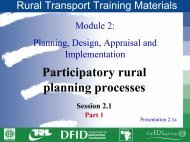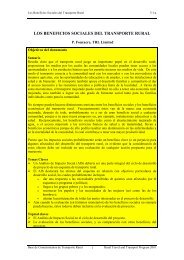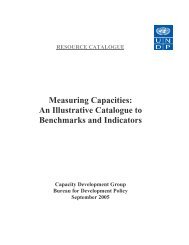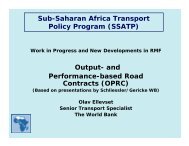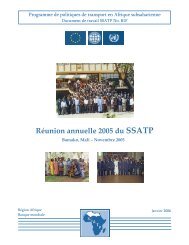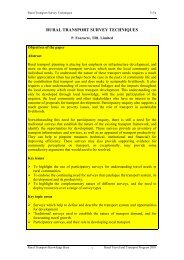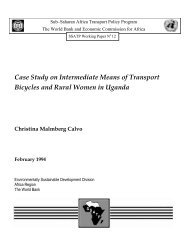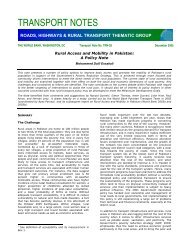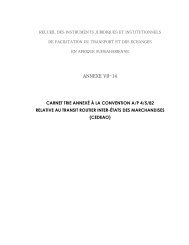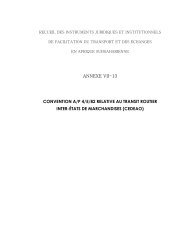Alternative Materials and Pavement Design ... - World Bank
Alternative Materials and Pavement Design ... - World Bank
Alternative Materials and Pavement Design ... - World Bank
You also want an ePaper? Increase the reach of your titles
YUMPU automatically turns print PDFs into web optimized ePapers that Google loves.
International Workshop, Nairobi, Kenya<br />
28th February– 1 st March 2006<br />
<strong>Alternative</strong> <strong>Materials</strong> <strong>and</strong> <strong>Pavement</strong> <strong>Design</strong> Technologies<br />
for Low-volume Sealed Roads + Case Studies<br />
Mike Pinard<br />
SSATP/<strong>World</strong> <strong>Bank</strong> Consultant<br />
mipinard@global.bw
Outline of Presentation<br />
• Introduction<br />
• <strong>Materials</strong> Issues<br />
• <strong>Pavement</strong> design issues<br />
• Other issues
<strong>Pavement</strong> design <strong>and</strong> materials<br />
<strong>Pavement</strong> structure terms
<strong>Pavement</strong> design <strong>and</strong> materials<br />
Requirements of <strong>Pavement</strong> structure<br />
Spread of wheel load through pavement structure
<strong>Pavement</strong> design <strong>and</strong> materials<br />
<strong>Pavement</strong> performance<br />
Generalised pavement behaviour characteristics <strong>and</strong> indicators
Examples<br />
Challenge of Using Natural Gravels<br />
• <strong>Materials</strong> typically make up 70% of total cost of LVSR<br />
• 90% of problems occurring on LVSRs are materials related<br />
• Overwhelming need to be knowledgeable about use of local materials<br />
‣ Tend to be variable <strong>and</strong> moisture sensitive – require use of appropriate designs,<br />
construction techniques <strong>and</strong> drainage measures<br />
‣ St<strong>and</strong>ard methods of test (e.g. CBR) often do not provide true assessment of performance<br />
‣ Conventional specs apply to “ideal” materials <strong>and</strong> preclude use of many natural gravels<br />
(grading, plasticity, strength)<br />
• Local road building materials often “non-st<strong>and</strong>ard”compared with temperate<br />
climate materials. Disparagingly referred to as “marginal”, “low cost”, etc.<br />
• Regional research work has allowed revised specs to be derived for major groups of<br />
natural gravel materials found in region.
Examples<br />
<strong>Materials</strong> Options<br />
Crushed limestone<br />
As-dug, nodular laterite<br />
Laterite<br />
Calcrete
<strong>Pavement</strong> design <strong>and</strong> materials<br />
The challenge<br />
• Existing pavement design methods cater to relatively high<br />
volumes of traffic with damaging effect quantified in terms of esa.<br />
In contrast, main factors controlling deterioration of LVRs are<br />
dominated by the local road environment <strong>and</strong> details of design<br />
(drainage), construction <strong>and</strong> maintenance practice.<br />
• Conventional specs apply to “ideal” materials<br />
• St<strong>and</strong>ard methods of test do not always give a true assessment<br />
of performance of local materials
<strong>Pavement</strong> design <strong>and</strong> materials<br />
<strong>Materials</strong> <strong>and</strong> specs<br />
• SADC road building materials mostly<br />
derived from weathering <strong>and</strong> pedogenesis<br />
• Each group has a characteristic range of<br />
properties <strong>and</strong> potential problems which<br />
should be taken into account by test<br />
methods <strong>and</strong> specs<br />
•Conventional specs often unnecessarily<br />
restrictive <strong>and</strong> can result in costly failures<br />
as well as over-conservative , uneconomic<br />
designs<br />
• Specs tied directly to test methods used<br />
in carrying out research work – dangerous<br />
to mix.<br />
Traditional specifications for base<br />
gravels typically specify a soaked<br />
CBR @ 98% MAASHO of 80%, PI of<br />
<strong>Pavement</strong> design <strong>and</strong> materials<br />
Using local materials<br />
“ The art of the roads engineer consists for a good part<br />
in utilising specifications that will make possible the use<br />
of materials he finds in the vicinity of the road works.<br />
Unfortunately, force of habit, inadequate specifications<br />
<strong>and</strong> lack of initiative have suppressed the use of local<br />
matereials <strong>and</strong> innovative construction technologies”<br />
Consider materials’ “fitness for purpose”<br />
Make specification fit materials rather than materials<br />
fit specification (“resource based” specs)
<strong>Pavement</strong> design <strong>and</strong> materials<br />
<strong>Pavement</strong> material characteristics<br />
<strong>Pavement</strong> Type<br />
• Material strength derived<br />
from combination of:<br />
- cohesive effects<br />
- soil suction<br />
- physio-chemical (stab) forces<br />
- inter-particle friction<br />
Parameter<br />
Material Types<br />
Variability<br />
Plastic<br />
Modulus<br />
Unprocessed<br />
As-dug gravel<br />
High<br />
High<br />
Unbound<br />
Processed<br />
Screened gravel<br />
Decreases<br />
Decreases<br />
Highly<br />
processed<br />
Crushed rock<br />
Bound<br />
Very highly<br />
processed<br />
Stabilised gravel<br />
Low<br />
Low<br />
• Material selection influenced<br />
by:<br />
Development of<br />
shear strength<br />
Cohesion <strong>and</strong><br />
suction.<br />
Cohesion, suction<br />
<strong>and</strong> some particle<br />
interlock.<br />
Particle interlock.<br />
Particle interlock<br />
<strong>and</strong> chemical<br />
bonding.<br />
- traffic loading<br />
- environment<br />
- material properties (plastic<br />
mod)<br />
- pavement configuration<br />
Susceptibility<br />
to moisture<br />
<strong>Design</strong><br />
philosophy<br />
High<br />
Material strength<br />
maintained only<br />
in a dry state.<br />
Decreases<br />
Selection criteria reduces volume of<br />
moisture sensitive, soft <strong>and</strong> poorly<br />
graded gravels<br />
Low<br />
Material strength<br />
maintained even<br />
in wetter state.<br />
Appropriate<br />
use<br />
Low traffic<br />
loading in very<br />
dry environment.<br />
Traffic loading increases, environment<br />
becomes wetter<br />
High traffic<br />
loading in wetter<br />
environments.<br />
Cost<br />
Low<br />
Increases<br />
High<br />
High<br />
Maintenance<br />
reliability<br />
High<br />
Decreases<br />
Low
Guide to Method of Stabilisation
Use of Proprietary Chemical Additives<br />
• Wide variety of chemical additives available including:<br />
‣Wetting agents to improve compaction<br />
‣Hygroscopic salts (e.g. calcium, magnesium or sodium chlorides)<br />
‣Natural polymers (e.g. ligno sulphonates)<br />
‣Synthetic polymer emulsions (e.g. acrylates)<br />
‣Modified waxes<br />
‣Sulphonated oils<br />
‣Biological enzymes
Experience with use<br />
Experience with use of Chemical Additives<br />
•42 products tested in Ghana in last 10 years<br />
• 42 products introduced in Ghana in last 10 years<br />
• No large scale application of any product<br />
• Some products may present some advantages but not<br />
cost effective<br />
• Claims of most products not real
<strong>Pavement</strong> design <strong>and</strong> materials<br />
Output of SADC research work<br />
• The grading envelopes for natural gravel bases<br />
are too narrow. <strong>Alternative</strong> (wider) envelopes are<br />
recommended for relatively lightly trafficked roads<br />
• The minimum st<strong>and</strong>ard of 80 per cent soaked<br />
CBR for natural gravel bases is inappropriately<br />
high for many LVSRs. New limits are<br />
recommended depending on traffic, materials <strong>and</strong><br />
climate.<br />
• Traffic below 300,000 to 500,000 esa was not a<br />
significant factor on pavement deterioration. Many<br />
road sections performed well even when<br />
subjected to a high degree of overloading <strong>and</strong> with<br />
PIs up to 18. New limits for PI are recommended.<br />
• Drainage was a significant factor on<br />
performance, even in dry areas. A minimum crown<br />
height of 0.75 m is recommended<br />
Extensive research has been<br />
undertaken in the SADC<br />
region over the past 20 – 30<br />
years. This has enabled local,<br />
“non-st<strong>and</strong>ard” materials to<br />
be successfully incorporated<br />
in appropriate pavement<br />
designs for LVSRs.
<strong>Pavement</strong> design <strong>and</strong> materials<br />
Output of SADC research work
<strong>Pavement</strong> design <strong>and</strong> materials<br />
CBR versus stiffness
<strong>Pavement</strong> design <strong>and</strong> materials<br />
Compaction/density/permeability<br />
A Plastic B Elasto-plastic C Elastic<br />
Density/Stiffness<br />
D 2<br />
I<br />
D 1<br />
N 1 N 2<br />
Compaction to refusal<br />
I<br />
I<br />
I<br />
No. of roller passes
<strong>Pavement</strong> design <strong>and</strong> materials<br />
Stiffness versus density
<strong>Pavement</strong> design <strong>and</strong> materials<br />
Dry density vs Permeability & Stiffness
<strong>Pavement</strong> design <strong>and</strong> materials<br />
Benefits of “Compaction to Refusal”<br />
Max Annual Deflection (mm)<br />
Reduction in deflection<br />
Increase in life<br />
deflection/life relationship<br />
<strong>Pavement</strong> Life (E80s)
<strong>Pavement</strong> design <strong>and</strong> materials<br />
Effect of Surface Deflection on Seal Life
C<br />
Compaction Options Open to Contractor<br />
Circular 3-sided impact 4-sided impact 5-sided<br />
Static/vibratory<br />
impact<br />
(Not to scale)<br />
• Wide array of compaction plant offers opportunities for dealing with a wide<br />
range of soil types <strong>and</strong> conditions, including thickness of layer<br />
• Necessary to make appropriate choice of plant as regards energy rating<br />
<strong>and</strong> shape in relation to prevailing soil conditions <strong>and</strong> layer thickness
C<br />
Characteristics of Compaction Plant<br />
jjjjjjjjjjjjj<br />
Type of STATIC VIBRATORY IMPACT<br />
energy static pressure low amplitude/ high amplitude/<br />
<strong>and</strong> kneading high frequency low frequency<br />
Probable extent of d3<br />
At CLK
C<br />
3-sided, 25 kJ impact compactor<br />
d<br />
Thin-lift, multi-layered compaction<br />
Thick-lift, single-layer compaction
C<br />
25 kJ, 3-Sided Impact Compactor
<strong>Pavement</strong> design <strong>and</strong> materials<br />
Shear strength versus soil suction<br />
Soil strength (CBR)<br />
75<br />
50<br />
25<br />
Equilibrium moisture content<br />
Optimum moisture content<br />
Soaked<br />
1 2 3 4<br />
Soil suction<br />
pF
<strong>Pavement</strong> design <strong>and</strong> materials<br />
<strong>Pavement</strong> design methods<br />
• Should be based on experience, theory, structural <strong>and</strong> material<br />
behaviour<br />
•Should take account of local conditions of climate, traffic, available<br />
local materials, other environmental factors<br />
• sub-grade classes: wide enough to take advantage of range od<br />
strong subgrades<br />
• <strong>Design</strong> traffic class: wide enough to cater incrementally for traffic<br />
loadings up to 0.5 m esa<br />
• Material classes: wide enough to cater for full range <strong>and</strong> differing<br />
properties of natural gravels<br />
• <strong>Materials</strong> specs should be based on proven field performance in<br />
relation to traffic, subgrade design class, geo-climatic zone, etc
<strong>Pavement</strong> design <strong>and</strong> materials<br />
<strong>Pavement</strong> design system<br />
5.4.3 - INPUT VARIABLES<br />
5.4.4 - DESIGN PROCESS 5.4.5 - DESIGN OUTPUT<br />
Construction <strong>and</strong><br />
Maintenance Factors<br />
External Factors<br />
(Chapter 3)<br />
Traffic<br />
Environmental<br />
Factors<br />
Structural <strong>Design</strong><br />
Cost Comparisons<br />
Selected <strong>Design</strong><br />
Subgrade Soils<br />
Implementation<br />
<strong>Pavement</strong> <strong>Materials</strong><br />
<strong>Pavement</strong><br />
Configuration<br />
<strong>Pavement</strong> design system
<strong>Pavement</strong> design <strong>and</strong> materials<br />
<strong>Pavement</strong> design methods<br />
Mechanistic-Empirical<br />
Methods<br />
• S-N Method (1993)<br />
•TRH4 (1996)<br />
Empirical Methods<br />
• DCP Method<br />
• SATCC <strong>Pavement</strong> <strong>Design</strong><br />
Guide (1997)<br />
• TRL/SADC <strong>Pavement</strong> <strong>Design</strong><br />
Guide (1999)<br />
Country-specific: Zimbabwe <strong>Pavement</strong> <strong>Design</strong> Guide (1975)<br />
Botswana Roads <strong>Design</strong> Manual(1982)<br />
Tanzania <strong>Pavement</strong> <strong>and</strong> <strong>Materials</strong> <strong>Design</strong> Manual (1999)<br />
South African Provincial <strong>Design</strong> Guides
Environmentally Optimised <strong>Design</strong>
<strong>Pavement</strong> design <strong>and</strong> materials<br />
Traffic characteristics<br />
• Most design methods used in SADC region cater for relatively high volumes of traffic, typically in<br />
excess of 0.5 million ESAs over a 10–15 year design life with attention focused on load-associated<br />
distress.<br />
• For large proportion of LVRs in the region, carrying < 0.30 million ESAs over their design life,<br />
priority attention should be focused on ameliorating effects of the environment, particularly rainfall<br />
<strong>and</strong> temperature, on their performance
<strong>Pavement</strong> design <strong>and</strong> materials<br />
Moisture movements
<strong>Pavement</strong> design <strong>and</strong> materials<br />
Moisture effects<br />
• Control of moisture is single<br />
most important factor controlling<br />
performance of LVSRs<br />
• Appropriate pavement<br />
configuration is critical for<br />
controlling moisture<br />
• Factors to be considered<br />
include:<br />
‣ shoulders<br />
‣ permeability inversion<br />
‣ internal, external drainage<br />
Moisture zones in a LVSR
<strong>Pavement</strong> design <strong>and</strong> materials<br />
<strong>Pavement</strong> configuration<br />
• <strong>Pavement</strong> configuration<br />
influenced by materials properties<br />
<strong>and</strong> influence of water on their<br />
properties<br />
• Attention to detail in drainage<br />
design <strong>and</strong> construction is<br />
essential for optimum<br />
performance<br />
• Essential to avoid permeability<br />
inversion
Examples<br />
LVSR <strong>Pavement</strong>s (ideal cross-section)<br />
<br />
d (m)<br />
Crown height:<br />
• Crown height is a critical<br />
parameter that correlates well<br />
with the actual service life of<br />
pavements constructed from<br />
natural gravels ( d ≥ 0.75 m)<br />
• Sealed shoulders reduce/<br />
eliminate lateral moisture<br />
penetration under carriageway<br />
• Avoiding permeability<br />
inversion facilittes good<br />
internal drainage<br />
39
Examples<br />
LVSR <strong>Pavement</strong>s (non-ideal cross-section)<br />
<br />
Crown height:<br />
d (m)<br />
39
Examples<br />
Effects of Moisture Penetration in Shoulder
<strong>Pavement</strong> design <strong>and</strong> materials<br />
Typical specifications<br />
Traditional<br />
19/9.5 mm max. size double<br />
surface treatment<br />
150 mm crushed stone base<br />
compacted t o 98% Mod AASHT O<br />
150 mm natural gravel G5 subbase<br />
compacted to 95% Mod AASHTO<br />
150 mm natural gravel G6 USSG<br />
compacted to 93% Mod AASHTO<br />
150 mm natural gravel G7 LSSG<br />
compacted to 93% Mod AASHTO<br />
Fill, where necessary, at least G10<br />
compacted t o 93% Mod AASHT O<br />
New<br />
19 mm max. size Otta seal surfacing<br />
wit h s<strong>and</strong>/crusher dust cover seal<br />
150 mm natural gravel G4 base<br />
compacted to refusal (100% Mod. AASHTO)<br />
150 mm natural gravel G5 subbase<br />
compacted to refusal (100% Mod AASHTO)<br />
150 mm natural gravel G6 USSG<br />
compacted to refusal (100% Mod AASHTO)<br />
150 mm natural gravel G7 LSSG<br />
compacted to refusal (100% Mod AASHTO)<br />
Fill, where necessary, at least G10<br />
compacted to refusal (100% Mod AASHTO)<br />
Life cycle cost ratio<br />
1.0 1.3 to 1.5
Benefits of Adopting Recommendations<br />
Option<br />
• Replacing a conventional geometric design process by a<br />
“design by eye” approach, where appropriate<br />
• Use of more appropriate pavement designs <strong>and</strong> natural<br />
gravel rather than crushed stone.<br />
• Utilising an existing gravel wearing course e.g. as base<br />
or sub-base .<br />
• Compacting pavement layers to refusal, where feasible,<br />
rather than to arbitrary prescribed levels.<br />
• Adopting appropriate surfacing technologies such as<br />
s<strong>and</strong> seals <strong>and</strong> Otta seals.<br />
• Increasing the use of labour <strong>and</strong> local resources where<br />
appropriate.<br />
• Using seals as a spot improvement measure.<br />
Potential Benefits<br />
• Reduced earth works <strong>and</strong> environmental damage.<br />
• Reduced pavement costs due to lesser haulage<br />
distances <strong>and</strong> reduced materials processing costs.<br />
• Reduced haulage distances <strong>and</strong> materials costs.<br />
• Increased density, reduced road deterioration <strong>and</strong><br />
increased maintenance intervals.<br />
• Reduced haulage distances, reduced processing costs.<br />
• Lower economic/financial costs for specific tasks.<br />
• Reduced surfacing costs whilst maintaining year round<br />
access.
<strong>Pavement</strong> design <strong>and</strong> materials<br />
Life cycle cost analysis<br />
Analysis Period<br />
NPV of Upgrading Investment ($)<br />
0<br />
Revised approaches<br />
75 + vpd<br />
Traditional approaches<br />
250 + vpd<br />
Costs during life cycle<br />
Structural Deign Period<br />
PC<br />
ST<br />
OV<br />
Key:<br />
PC = Initial <strong>Pavement</strong> Construction<br />
RM = Routine Maintenance<br />
ST = Surface Treatment<br />
RV = Residual Value<br />
OV = Overlay<br />
RM RM RM RM<br />
ST<br />
RV<br />
Time (Years)<br />
Initial Average Daily Traffic (vpd)<br />
Break-even traffic<br />
Traditional vs revised approaches<br />
Components of a Life Cycle Costing
Examples<br />
Overloading<br />
Axles of evil
Examples<br />
Impact of Overloading on <strong>Pavement</strong>s
Examples<br />
Impact on <strong>Pavement</strong>s<br />
<strong>Pavement</strong> performance<br />
under legal load limits<br />
<strong>Pavement</strong> performance<br />
under overloading
Examples<br />
Cost of Overloading<br />
• Botswana – 2004: US $2.6 million<br />
• South Africa – 2002: US $100 million<br />
• Sub-Saharan Africa – 2004:<br />
US $500 million
Examples<br />
Developments in Overload Control<br />
• M<strong>and</strong>atory off-loading of over-loaded vehicles<br />
• Decriminalisation of offenses for overloading by h<strong>and</strong>ling them<br />
administratively <strong>and</strong> imposing a requirement on the overloader to<br />
pay an overloading fee<br />
• Linking level of imposed fees for overloading with actual cost of<br />
road damage, i.e. by imposing economic fees<br />
• Outsourcing weighbridge operations to the private sector on a<br />
concession basis, i.e. embarking on a commercialised<br />
public/private sector approach to overload control
Examples<br />
Modern Weighbridge Equipment
Examples<br />
Environmental issues – borrow pits<br />
Typical, un-renovated borrow-pit in the SADC region<br />
• Children exposed to risk of drowning <strong>and</strong> poor quality water<br />
• Ponding increases level of mosquito-borne disease<br />
Introduction of<br />
Technical Audits at<br />
Feasibility Stage
Before<br />
Examples<br />
Environmental issues – borrow pit restoration<br />
After
The Final Result – A Meeting of Minds
The Final Result<br />
The successful engineering of a low volume sealed road requires ingenuity, imagination <strong>and</strong> innovation. It entails<br />
“working with nature” <strong>and</strong> using locally available, non-st<strong>and</strong>ard materials <strong>and</strong> other resources in an optimal <strong>and</strong><br />
environmentally sustainable manner.<br />
It will rely on planning, design, construction <strong>and</strong> maintenance techniques that maximize the involvement of local<br />
communities <strong>and</strong> contractors.<br />
When properly engineered to an appropriate st<strong>and</strong>ard, a LVSR will reduce transport costs <strong>and</strong> facilitate socioeconomic<br />
growth <strong>and</strong> development <strong>and</strong> reduce poverty in the SADC region.
Finally – Our Vision<br />
“It is not wealth which makes good roads possible –<br />
but, rather, good roads which make wealth possible<br />
–Adam Smith
Thank you







